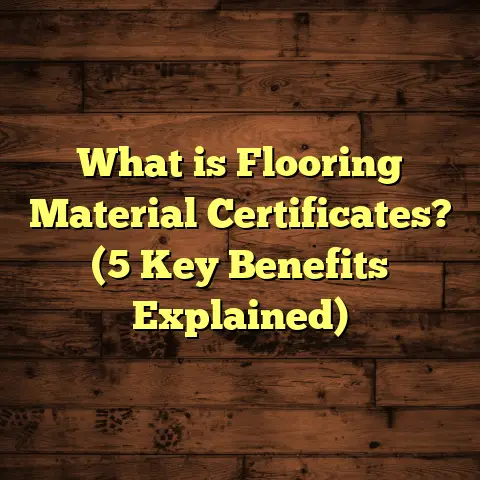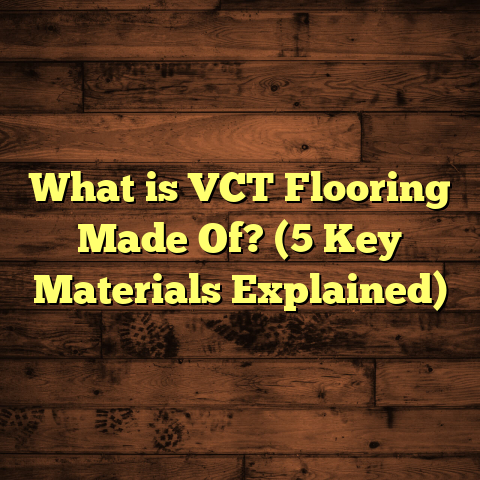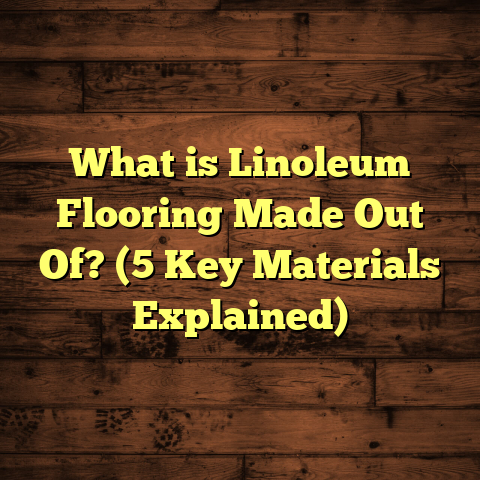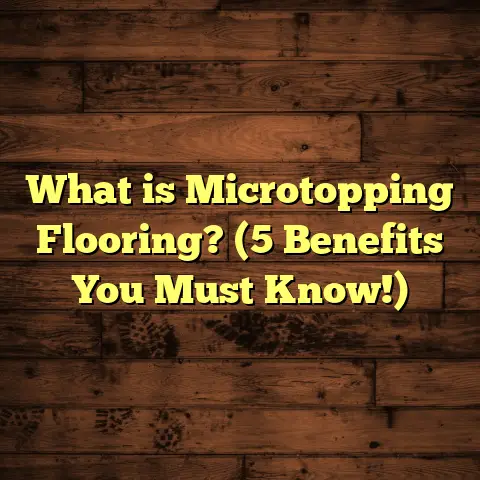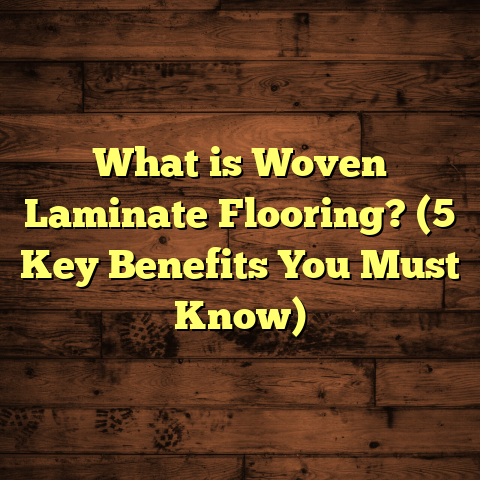What is Vinyl Flooring for Basements? (5 Key Tips to Consider)
Have you ever walked into a basement and felt that chill—not just from the air, but from the flooring beneath your feet? Maybe it was cold concrete or a damp carpet that made you hesitate to spend time there. I’ve been in basements like those countless times. Over the years, I discovered vinyl flooring as a game-changer for basement spaces. If you think vinyl is just another cheap flooring option, stick with me. I’ll share what vinyl really is for basements, what I’ve learned from hands-on experience, and five key tips that can help you avoid common pitfalls.
What is Vinyl Flooring for Basements?
Vinyl flooring, simply put, is a synthetic floor covering made primarily of polyvinyl chloride (PVC). It’s crafted to mimic natural materials like wood, stone, or tile but comes with superior resilience and moisture resistance. For basements, vinyl’s moisture-handling capabilities make it an attractive choice compared to other flooring materials.
But vinyl isn’t one-size-fits-all. When I talk about vinyl flooring for basements, I’m referring to products designed or proven suitable for spaces below ground level where moisture and humidity are more than occasional concerns. These products usually come with waterproof cores, durable wear layers, and installation methods that accommodate the unique challenges of basements.
Here’s a quick breakdown of what vinyl flooring includes:
- Sheet Vinyl: Large rolls of vinyl that create a continuous sheet when installed.
- Luxury Vinyl Tile (LVT): Vinyl designed in tiles that replicate stone or ceramic.
- Luxury Vinyl Plank (LVP): Vinyl planks that look like hardwood floors.
Each type has its own installation requirements and durability factors, which I will cover along the way.
Why Basements Pose Unique Flooring Challenges
Before diving deeper into vinyl, it’s worth thinking about why basement floors are tricky in the first place:
- Moisture: Basements are below grade, so water seepage or high humidity often occurs.
- Cold temperatures: Concrete slabs can feel cold underfoot.
- Uneven surfaces: Older basements often have uneven or cracked slabs.
- Low light: Basements usually have limited natural light, so flooring aesthetics matter.
- Usage variety: Basements serve many purposes—from gyms to entertainment zones to storage spaces—meaning floors need to be versatile.
I’ve faced all these challenges to varying degrees on different projects. Vinyl flooring often stands out because it addresses most of these issues better than alternatives like hardwood, laminate, or carpet.
My Initial Experience with Basement Flooring: Lessons Learned
I remember early in my career installing hardwood floors in a basement renovation project. The owners were excited about having real wood floors down there, but within months parts of the floor started warping and cupping due to moisture. The damage was a costly lesson in why certain floor types don’t belong below ground without extensive moisture control measures.
That experience sparked my interest in finding basement-friendly materials. Over time, I experimented with tile, engineered wood, laminate, and vinyl floors. Each had pros and cons:
- Tile: Waterproof and durable but cold and hard, making the basement feel less cozy.
- Engineered wood: Better moisture resistance than solid wood but still vulnerable to damp conditions.
- Laminate: Affordable and stylish but prone to swelling if water reaches the core.
- Vinyl: Waterproof options available, warm underfoot with cushioned underlayments, and highly durable.
Vinyl quickly became my go-to for basements because it combined durability with comfort and moisture resistance without breaking the bank.
Comparing Vinyl Flooring Options I’ve Used in Basements
Let me walk you through how sheet vinyl, LVT, and LVP have performed on various basement projects:
Sheet Vinyl
Sheet vinyl is typically sold in large rolls that are cut to size and glued down or loose-laid. On one basement job, we used sheet vinyl because the client wanted a seamless waterproof surface over a slab with minor cracks.
The seamless nature of sheet vinyl means there aren’t many seams where water can infiltrate. This makes it excellent for basements where minor flooding or seepage might happen. However, I found sheet vinyl can sometimes feel less natural underfoot compared to planks or tiles. Also, patterns are printed on the surface layer rather than textured deeply.
Luxury Vinyl Tile (LVT)
LVT delivers a stone or ceramic tile look with all the benefits of vinyl. It’s thicker than sheet vinyl and often has textured surfaces to imitate grout lines or stone irregularities.
In a basement remodel for a client who loved the look of natural stone but feared cold tiles, we installed LVT with an underlayment that gave some cushion and warmth. The LVT handled moisture well and looked classy. The only caveat was that grout lines between tiles can trap dirt if not sealed properly.
Luxury Vinyl Plank (LVP)
LVP mimics hardwood floors very well and is probably my favorite choice for basements now. It comes in waterproof versions with rigid cores (SPC or WPC), which provide stability on uneven concrete slabs.
In one project, we installed LVP over an older slab with cracks and slight unevenness. The planks clicked together easily with a floating floor method and provided warmth and style that transformed the basement into a welcoming living area. The waterproof core meant we didn’t have to stress about humidity changes or minor leaks.
5 Key Tips I’ve Learned About Vinyl Flooring for Basements
1. Test Basement Moisture Before Installation
One crucial step I always take is measuring moisture levels in the concrete slab before installing any flooring. Moisture testing can reveal if your slab is too damp and help avoid potential problems like adhesive failure or mold growth beneath the floor.
There are several ways to test moisture:
- Calcium Chloride Test: Measures moisture vapor emission rate from concrete.
- Relative Humidity Test: Measures humidity trapped inside the slab.
- Digital Moisture Meters: Provide quick readings near the surface.
I usually recommend doing at least two tests for accuracy.
One project I worked on had elevated moisture vapor levels. Instead of installing directly over the slab, we applied a moisture barrier sealer first. That extra step prevented bubbling and warping later on.
2. Pick Waterproof Vinyl Products
Vinyl products vary widely in terms of their water resistance. Some have waterproof cores like:
- WPC (Wood Plastic Composite): Softer core made from wood fibers and plastic.
- SPC (Stone Plastic Composite): Denser, more rigid core made from limestone and PVC.
I prefer SPC for basement installations because it handles water better and stays flat on uneven slabs. WPC feels softer but is less dimensionally stable under heavy furniture or uneven floors.
Check product specifications carefully before buying—look for claims like “100% waterproof” or “suitable for below-grade installation.”
3. Choose Your Installation Method Wisely
Vinyl can be installed in several ways:
- Glue-down: Adhesive applied directly to the subfloor.
- Floating: Planks or tiles click-lock over an underlayment without glue.
- Loose lay: Tiles or planks laid down without adhesive but with friction backing.
For basements, floating floors are often best because they allow some movement without damaging the floor if moisture causes slight swelling underneath. Glue-down floors can be risky if moisture seeps through.
In one basement gym project, we used floating LVP over a cushioned underlayment for comfort and ease of repair if needed later.
4. Use Underlayment for Warmth and Sound Control
Concrete can be cold and noisy. Adding an underlayment beneath your vinyl improves comfort significantly.
I’ve installed cushioned underlayments made from foam, cork, or rubber beneath vinyl floors in basements used as living spaces or gyms. These materials absorb impact noise by up to 30% and make standing or walking on the floor more pleasant.
On one project where kids played frequently in the basement playroom, adding cork underlayment beneath LVT helped reduce echoes and muffled footsteps upstairs.
5. Maintain Your Vinyl Floor Properly
Vinyl floors are low maintenance but benefit from regular care:
- Sweep or vacuum regularly to prevent grit buildup that can scratch wear layers.
- Use damp mops with mild cleaners; avoid harsh chemicals or abrasive tools.
- Clean spills quickly to prevent stains.
- Avoid excessive water pooling on seams or edges.
One busy family I worked with appreciated how easily they could mop wine spills after parties without worrying about permanent damage—a big advantage over carpeted basements they had before.
Data That Supports Choosing Vinyl for Basements
Here are some numbers from industry research and my own observations:
| Factor | Vinyl Flooring Data | Comparison Notes |
|---|---|---|
| Water Resistance | SPC vinyl: up to 100% waterproof | Laminate: vulnerable to water damage |
| Durability | 10–20 years average lifespan | Hardwood: 15–25 years but less moisture resistant |
| Cost per square foot | $2 – $7 installed | Tile: $5 – $15; Hardwood: $6 – $12 |
| Noise Reduction | Up to 30% impact noise reduction with underlayment | Concrete alone is very noisy |
| Maintenance | Low; simple sweeping & damp mopping | Carpet requires frequent deep cleaning |
These data points align with what I’ve seen across dozens of basement installations—vinyl offers a balanced package of affordability, durability, and comfort that’s hard to beat below grade.
Case Study: Basement Transformation Using SPC Vinyl Plank
Let me share a recent job that highlights why vinyl is such a great basement option:
The homeowner wanted a cozy family room in their unfinished basement but was worried about moisture issues since their neighborhood had periodic flooding during heavy rains.
We started by testing the concrete slab’s moisture vapor levels using both calcium chloride tests and digital meters. Results showed moderate moisture emission but no active leaks.
We applied a high-quality moisture barrier sealant over the slab first. Then we installed a premium SPC luxury vinyl plank floor using a floating method over an acoustic underlayment.
The client was thrilled with how warm the floor felt—even without radiant heating—and how realistic the wood-look planks appeared. After several months of use through wet weather seasons, no issues arose with warping or bubbling.
This project illustrated how combining moisture testing, barrier application, waterproof vinyl selection, and proper installation can result in durable basement floors that look great and feel comfortable year-round.
Common Questions I Get About Vinyl Flooring in Basements
Is vinyl flooring really waterproof?
Most modern luxury vinyl products are waterproof at the plank or tile level due to their PVC layers and cores like SPC/WPC. However, seams might still allow water infiltration if not installed properly or if flooding occurs. Always pair vinyl with good moisture control practices for best results.
Can vinyl flooring handle basement temperature changes?
Yes! Vinyl has some flexibility that helps it adjust to temperature fluctuations without cracking like ceramic tile might. Rigid core versions also maintain dimensional stability better than laminate under varying temps.
How long does vinyl flooring last in basements?
With proper care, expect 10–20 years depending on wear layer thickness and foot traffic levels. Commercial-grade vinyl floors with thicker wear layers last longer but cost more upfront.
What about mold risks under vinyl?
If moisture seeps into gaps or beneath glued-down floors without proper vapor barriers, mold can grow. That’s why testing slab moisture beforehand and installing vapor barriers/sealers is critical.
Is vinyl flooring eco-friendly?
Vinyl is made from PVC—a plastic—so it’s not biodegradable but many manufacturers now offer recycled content options and recycling programs to reduce environmental impact.
More Stories from My Basement Flooring Projects
One client wanted a home theater room in their basement; they chose LVT with a wood grain finish for aesthetics plus an acoustic underlayment for sound dampening. The result? A cozy space where sound quality improved dramatically while looking sleek.
Another client needed a pet-friendly basement playroom that could withstand scratches and accidents. We installed SPC LVP with a matte finish that hides scratches well and cleaned easily after messes—a win-win for their active household.
In an older home with uneven concrete slabs cracked by time, we prepared the surface carefully by grinding down high spots then installed floating vinyl plank flooring that accommodated slight floor movement while hiding imperfections visually.
Final Thoughts From My Years Working With Basement Vinyl Floors
Basement flooring isn’t just about function—it affects how you use your space daily. Vinyl provides options that combine style, durability, comfort, and moisture resistance all at once. It’s no wonder I keep recommending it for basements after seeing how it performs across different homes and conditions.
If you’re planning basement renovations or finishing an unfinished space, think carefully about your specific needs: moisture levels, comfort preferences, budget constraints, and desired aesthetics. Then consider which type of vinyl suits those priorities best—sheet vinyl for seamless waterproofing; LVT for stone-like elegance; or LVP for warm wood looks with rugged cores.
Feel free to ask me more about installation tips or product recommendations based on your exact situation—I’m happy to share what I’ve learned firsthand!
If you want me to add more technical details on installation methods or breakdown costs further with examples from FloorTally estimates I’ve used professionally, just say so!

